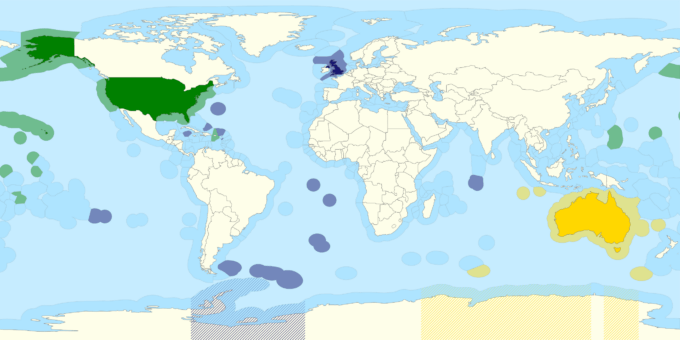AUKUS, Technology and Militarising Australia

Territories and territorial waters of Australia (yellow), the United Kingdom (blue), and the United States (green), including the respective Antarctic claims of Australia and the UK. Image Source: BilledMammal – CC BY-SA 4.0
Thinktanks across Australia, tanked with cash from US sources and keen to think in furious agreement, are all showing how delighted they are with the AUKUS security pact and what potential it has for local, if subordinated industry. The United States Studies Centre, a loudspeaker for Washington’s opinions based at the University of Sydney, has added its bit to the militarising fun with a report on what AUKUS will be able to do.
The author of the report, non-resident fellow of the US Centre’s Foreign Policy and Defence program Jennifer Jackett gushes about the “more consequential” nature of various “technological developments in quantum, cyber, artificial intelligence, undersea, hypersonics and electronic warfare” than nuclear-powered submarines. The latter are, after all, slated to appear much later on the horizon. In the meantime, warring potential could be harnessed in other realms.
Jackett stresses the urgency of appreciating these fields, given that Australia faces “a more hostile Indo-Pacific”. No ironic reflection follows that such hostility has been aided, in no small part, by the AUKUS security pact that has put countries in the region, with China being the primary target, on military notice.
In dealing with such threats, the AUKUS partners – the US, UK and Australia – had to “understand areas of comparative advantage, complementarity, and potential gaps or overlaps, between the three industrial bases.”
Reading, at points, like an intelligence comb through of local assets and wealth resources by a future colonising power, the report is revealing about what Vince Scappatura called that “loose networks of elites and institutional relationships” that nourish Australia’s umbilical cord to Freedom Land.
Australia’s population is described in glowing terms, with some nose-turning suggestions for improvement for the happily compliant subjects. “Australia stands out for the quality of its educational institutions and skilled workforce. Australian scientists are renowned for the global impact of their research in fields such as quantum physics and artificial intelligence.” There is, however, a belated admission that Australia’s STEM workforce, with 16 per cent of qualifications in the field, come behind that of the United States, “where around 23 per cent of the total workforce has a university-level or below STEM qualification.”
Then comes a mild rebuke in terms of Australian approaches to venture capital. One can see Jackett shaking her head in disapproval in writing this: “Australia remains an attractive destination for foreign direct investment, but the venture capital industry – the sort of financial entities willing to make riskier investments on unproven technology – remains small, less than half of the OECD average.” (Come on Aussies, whole frontiers of lethal technology await your dosh.)
This is not a meditation about peace, about miracle responses to climate change, poverty or wretched disease. It has nothing to do with harnessing the technological potential to aid good causes. This is the paid-up chit-chat of imperial militarisation, and how “innovation” aids it.
Similar remarks have been made by Admiral Mike Rogers, former chief of the US National Security Agency, who has given a stirring performance on his visit to Australia in praising his hosts. “I applaud Australia’s willingness to make that sort of commitment [to acquiring nuclear-powered submarines] and to speak about it so frankly,” he told Australia’s premier Murdoch rag, The Australian.
What troubles Rogers, as with those at the US Studies Centre and similar groupies, is a concern about what to do before those white elephants of the sea make their ponderous appearance. He cites various other weapons capabilities as “alternatives in the interim”. There are, for instance, options in “autonomous vehicles, robotics, sensors, situational awareness technologies”. AUKUS was, and here, the warning is clear to us all, “much more than submarines”. AUKUS needed to be used “to drive change.”
The disconcerting blindness to local security elites in turning Australia into something even more of a fortress for foreign military operations is palpable. Its corollary is the idea that the United States does not get into the empire business. The mechanism of kitting out Canberra as yet another appendage of US strategic operations and interests was already well underway with such fora as the Australian American Leadership Dialogue, which makes it very clear who the leaders are.
As things stand, the current makeup of the AALD features appropriately qualified vassals for the US mission. There is Tony Smith, former Speaker of the Australian House of Representatives, who is the CEO of the group. On being appointed to the position, he claimed it would “enable me to continue my service to our democracy and our nation in this vitally important, unique, bipartisan, private sector diplomatic endeavour”. Grovelling journalists wondered if Smith got along with his future masters. “Pretty good, I think,” came his response.
The newly appointed Secretary of the Department of Prime Minister and Cabinet, Glyn Davis, also appears as a prominent member on the advisory board, linking one of the most important civil service roles in Canberra to the US administration. The grouping is secretive and observes non-disclosure rules that would make any official in Beijing proud.
From the Australian Strategic Policy Institute to the US Studies Centre, we are meant to celebrate the prospect of Australia as a military annexe to US power in the Asia-Pacific, its sovereignty status subsumed under the ghastly guff of freedom lovers supposedly facing oriental barbarians. The analysis is then crowned by the praise of former US defence and security officials who ingratiatingly speak of Australian potential as they would mineral deposits. The lie, packaged and ribboned, is duly sold for public consumption. Australian sovereign capability becomes the supreme fiction, while its subservience is hidden, only to be exposed by heretics.

0 Comments:
Post a Comment
Subscribe to Post Comments [Atom]
<< Home